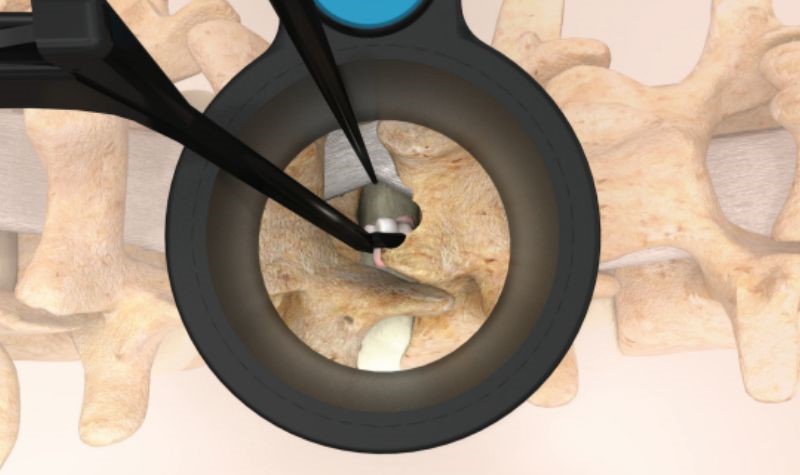Most patients have heard the phrase “slipped disc”, “ruptured disc” or “disc popped out”. While these are certainly descriptive terms, they can be somewhat misleading. What these terms are referring to is a disc herniation. Disc herniations are common, especially in the low back (i.e. lumbar spine), and at our practice in New Jersey, we treat lumbar herniated discs regularly.
A lumbar herniated disc is a common cause of low back and leg pain. Discs, which act as shock absorbers for the spine, are located in between each of the vertebrae in the spine. Each disc contains a tire-like outer band (called the annulus fibrosus) that surrounds a gel-like substance (called the nucleus pulposus).
A herniation occurs when the outer band of the disc breaks or cracks and the gel-like substance from the inside of the disc leaks out, placing pressure on the spinal canal or nerve roots. In addition, the nucleus releases chemicals that can irritate the surrounding nerves causing inflammation and pain.
Most lumbar disc herniations our New Jersey back pain doctors see occur as a result of sudden stress, such as from an accident. Sometimes they occur gradually, over weeks or even months. The risk factors that can contribute to the chances of a disc herniation, include:
Symptoms of a lumbar disc herniation may include the following:
Good treatment is always based on an accurate diagnosis. Our comprehensive diagnostic process includes:
The good news is that most cases of lumbar disc herniation our New Jersey back doctors deal with do not require surgery! Long-standing evidence suggests that pain associated with a herniated disc often diminishes without surgical treatment within 4-6 months. Unfortunately, it is not possible to predict which cases will have natural resolution, and which will not. Thus, patients are usually prescribed non-surgical treatments initially to help relieve symptoms.

Barricaid is a small implant, slightly larger than a pencil eraser that is designed to plug the larger holes in the disc wall. It is made up of a titanium bone anchor which secures the polymer plug into the disc space to repair and reconstruct disc wall.
Patients who undergo the Barricaid procedure following discectomy often can return to work and activities quicker than those who undergo discectomy alone. At IGEA, patients are enrolled in a recovery protocol that focuses on resistance training and core conditioning to build abdominal and lumbar core strength. Barricaid enables patients to restore confidence in their body following discectomy surgery by reducing the risk of reherniation, allowing them to quickly return to the activities they love most.
A combination of the following treatments will be used with most herniated disc patients:
If after non-surgical treatment the patient still has intolerable pain, or if there is evidence of neurosurgical deficit (e.g. weakness in the calf muscles) then we may recommend surgery to treat the disc herniation.
To relieve nerve pressure and leg pain, surgery usually involves removing part or all of the damaged disc. This is called a discectomy. At our practice, this procedure can often be done utilizing minimally invasive techniques. Minimally invasive surgery uses smaller incisions and specialized technology such as microscopes and endoscopes (“mini-video cameras”). Microdiscectomy and minimally invasive techniques often result in quicker patient recovery times compared to traditional techniques, as they reduce trauma to muscles and minimize blood-loss during surgery.

Spine fusion is rarely necessary when a disc is herniated for the first time. If necessary, the space left by the removed disc may be filled with a bone graft – a small piece of bone usually taken from the patient’s hip. The bone graft or a bone substitute is used to join or fuse the vertebrae together. In some cases, specially designed instrumentation (such as rods or screws) may be used to help promote fusion and to add stability to the spine.
In addition to a discectomy, a portion of the bone covering the nerve may also need to be removed. This procedure is called a laminectomy.
At our spine center in New Jersey, most patients can begin getting out of bed on the same day surgery is performed. Activity is gradually increased and patients are typically able to go home within 24 hours after their procedure, depending on the extent of the surgery. There will probably be some pain after the procedure. However, we have pain medications available that will keep you comfortable.
At home, you will need to continue to rest. You will be instructed on how to gradually increase your activity. You may still need to take the pain medications for a while. However, pain and discomfort should begin to reduce within a week or two after surgery. We will discuss with you other techniques for reducing pain and increasing flexibility before you leave for home. Our New Jersey spine center will also discuss with you a timeframe for when you can resume basic activities such as walking, driving and light lifting, and when you can return to more advanced activities such as work, sports and yard work.